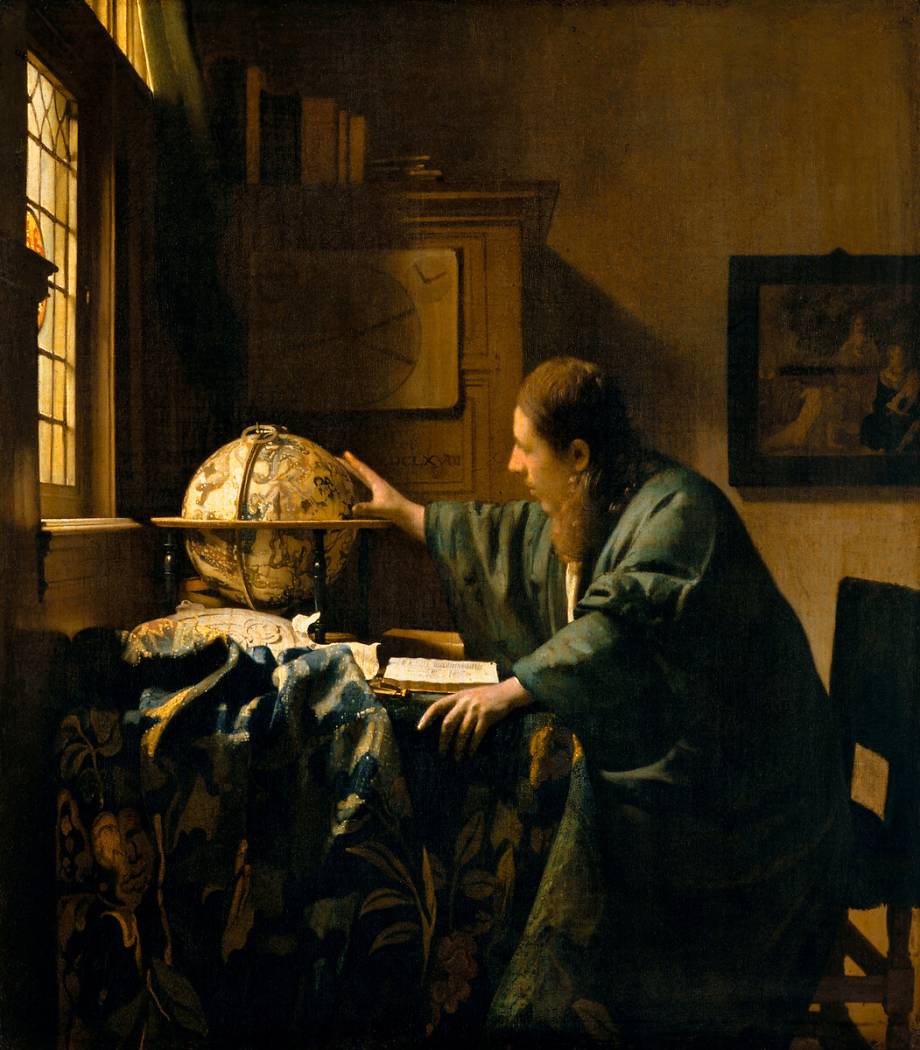Shop art print and framed art The Astronomer by Johannes Vermeer
Customise
Your art print
The Astronomer OF Johannes Vermeer
The Astronomer
Vermeer's The Astronomer: a context of scientific effervescence
The 17th century in the Netherlands, known as the Dutch Golden Age, was a period of economic prosperity and intense intellectual activity. Scientific advances were numerous, notably in astronomy, thanks to the work of Copernicus, Galileo and Kepler. Navigation, essential to the maritime trade that made the United Provinces rich, also stimulated interest in cartography and astronomy.
It was against this backdrop of intellectual effervescence that Johannes Vermeer painted The Astronomer around 1668, an oil on canvas depicting a man absorbed in studying a celestial globe in an interior bathed in soft, warm light. The identity of the figure depicted remains uncertain, but some art historians have speculated that it could be Antoni van Leeuwenhoek, a scientist contemporary of Vermeer, known for his work in microscopy and with whom the artist would have had ties. The painting, emblematic of the golden age of Dutch painting, fascinates with its harmonious composition and meticulous realism, and testifies to the importance attached to science and knowledge at the time, and the fascination with exploring the world and the universe.
L'Astronome : A harmonious, luminous composition
This work, of modest dimensions (51 cm high by 45 cm wide), is constructed by Vermeer according to a rigorous, balanced composition. The astronomer, positioned slightly to the right of center, is illuminated by natural light from a window to the left. This light, characteristic of Vermeer's work, bathes the scene in a soft, intimate atmosphere.
The figure is dressed in a loose-fitting robe, an element that evokes both domestic comfort and the exoticism of scientific discoveries. The hand on the celestial globe, placed in the center of the painting, draws the viewer's gaze and forms the focal point of the composition. The other elements, such as the open book or astrolabe, are carefully arranged to create a harmonious, balanced whole.
The Astronomer: a man absorbed by his quest for knowledge
The main character is depicted in a three-quarter view, leaning slightly toward the celestial globe he appears to be studying intently. His face is serene and focused, expressing deep absorption in his task. His right hand rests delicately on the globe, while his left hand is close to an open book identified as an astronomy textbook by Adriaan Metius. This suspended gesture and the various objects thus symbolize the quest for knowledge, the study and transmission of knowledge.
Vermeer attaches great importance to rendering details: the folds of clothing, facial features, reflections on objects are painted with meticulous precision. The light that bathes the scene can be interpreted as a metaphor for the divine light that illuminates the astronomer's mind in his search for truth. The painting thus invites reflection on man's place in the universe, on the relationship between science and faith, and on the quest for knowledge that drives mankind. The astronomer thus appears as an erudite man, passionate about knowledge and the discovery of the universe.
The Astronomer: A milestone in Vermeer's work and in the history of art
The Astronomer is considered one of Johannes Vermeer's major works. It is a precious testimony to the golden age of Dutch painting and the interest in science that characterized the period. This painting, currently housed at the musée du Louvre in Paris, undoubtedly contributed to Vermeer's fame, albeit belatedly, but above all it influenced many artists, fascinated by his mastery of light, his meticulous realism and the depth of his symbolism.
This artwork is a painting from the classical period. It belongs to the baroque style.
« The Astronomer » is kept at Louvre, Paris, France.
Find the full description of The Astronomer by Johannes Vermeer on Wikipedia.



































